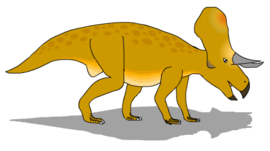Zuniceratops facts for kids
Quick facts for kids ZuniceratopsTemporal range: Late Cretaceous
|
|
|---|---|
 |
|
| Life restoration of Zuniceratops | |
| Conservation status | |
|
Fossil
|
|
| Scientific classification | |
| Kingdom: | |
| Phylum: | |
| Class: | |
| Superorder: | |
| Order: | |
| Suborder: | |
| Infraorder: | |
| Genus: |
Zuniceratops
|
| Species: |
Z. christopheri
|
| Binomial name | |
| Zuniceratops christopheri Wolfe & Kirkland, 1998
|
|
Zuniceratops was a type of horned dinosaur that lived a long, long time ago. It was a plant-eating dinosaur, part of a group known for their frills and horns.
This dinosaur could grow quite large, reaching about 13 feet (or 4 meters) in length. It weighed around 2 tons, which is like two small cars! Scientists gave it the full scientific name Zuniceratops christopheri.
Contents
What is Zuniceratops?
Zuniceratops is a fascinating dinosaur that lived during the Late Cretaceous period. This was about 90 million years ago! It's an important dinosaur because it helps us understand how horned dinosaurs evolved.
Where did Zuniceratops live?
Fossils of Zuniceratops were first found in New Mexico, United States. This discovery was very exciting for paleontologists. It showed that horned dinosaurs were also living in North America, not just Asia as previously thought for their early forms.
What did Zuniceratops look like?
Zuniceratops had a unique appearance. It was one of the first horned dinosaurs to have true brow horns, like the much later Triceratops. It also had a bony frill at the back of its head. This frill might have protected its neck or helped it show off to other dinosaurs.
How big was Zuniceratops?
Imagine a dinosaur as long as a school bus, but shorter! Zuniceratops was about 13 feet (4 meters) long. It stood on four strong legs. Its size made it a formidable animal in its ancient environment.
What did Zuniceratops eat?
Like all ceratopsian dinosaurs, Zuniceratops was a herbivore. This means it ate plants. It likely used its strong beak-like mouth to snip off tough plants and ferns. Its teeth were good for grinding up this plant material.
Discovery of Zuniceratops
The first fossils of Zuniceratops were found by a young boy named Christopher James Wolfe in 1996. He was with his father, Douglas G. Wolfe, who is a paleontologist. This discovery was made in the Moreno Hill Formation in New Mexico.
When was Zuniceratops named?
Scientists officially named Zuniceratops in 1998. The name Zuniceratops means "Zuni horned face." This name honors the Zuni people, a Native American tribe who live near where the fossils were found. The species name, christopheri, honors Christopher James Wolfe, who found the first bones.
Images for kids
See also
 In Spanish: Zuniceratops christopheri para niños
In Spanish: Zuniceratops christopheri para niños



